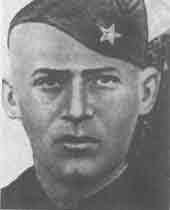
Idel Khait
Idel Khait (in some documents his name is spelled Khayit) was born in 1914 in the town of Khashchevatoye (formerly in the Odessa Region, now in the Kirovograd Region). His parents died when Idel was 5 years old and the little orphan was brought up by distant relatives. He lived for some time in Odessa, which he came to love. Despite the fact that, in the late 1930s, he moved to the town of Gaivoron, close to his native village of Khashchevatoye, he regarded himself as a native of Odessa. He worked as a barber. He married in the 1930s and had a son. In 1939-40, Khait was drafted and fought in the 1939-1940 Soviet-Finnish war.
Idel Khait was drafted again, for the Soviet-German war, on July 19, 1941. In the fall of 1942, Sergeant Khait was stationed in Stalingrad, where he was one of the defenders of the famous "Pavlov house."
"The Pavlov house" was a four-story apartment building located in a prestigious district of Stalingrad, close to the administrative buildings of the city. Most significantly the street on which the house had been built was the straightest and easiest way down to the Volga River. Thus, the small Red Army garrison deployed in the house was able to block the enemy's access to the river. The Germans attacked the house relentlessly, but the small garrison under the command of Sergeant Pavlov defended the house for 58 days, from September to November 1942. After the war, Marshal Chuikov, the commander of the Soviet 62nd Army that had defended Stalingrad claimed that in their assault against "The Pavlov house," the Germans lost more soldiers than during their conquest of Paris in 1940. Although no one has been able to estimate the German losses at that house, it is clear that their losses were massive.
Khait's optimism and sense of humor endeared him to his fellow defenders of the building he referred to as Noah's Ark. At the most desperate moments, Khait was able to raise the morale of his fellow soldiers. At one stage of the defense, Khait was sent, with another Red Army man to bring more ammunition to the Pavlov House. On the way the other soldier asked Khait what his first name was. When Khait replied "Idel," the soldier replied: "You must be a Jew!" Khait retorted: "I can see that you are quite a smart fellow." The soldier replied: "I knew another Jew once and he was smart like you.' [Recollections of Colonel Iurii Levin about Khait, cited from Posviashchaetsia evreiam Rossii XX veka, prinimavshim aktivnoe uchastie v boevykh deistviakh i stroitelstve gosudarstva]
Khait was killed by an enemy shell in November 1942, on the last day of the defense of the Pavlov's House, just hours before reinforcements arrived and lifted the enemy's siege of the house. He was buried in a common grave in the city center.
The fact that there were soldiers belonging to eleven different ethnic groups of the Soviet Union (including Russians, Ukrainians, a Georgian, a Tartar, a Turkoman, an Uzbek, a Kalmyk, and a Jew) among the defenders of The Pavlov House was a source of pride for some Soviet historians. They hailed it as a dramatic illustration of the interethnic friendship that was supposed to be flourishing in the Soviet state. However, The History of the Great Patriotic War of the Soviet Union 1941-1945 (eds. P. Pospelov et al., 1960-1965) fails to mention that one of the defenders was Jewish and, in the same vein, the album The Battle of Stalingrad (1982) did not mention Khait as being among the last victims to fall in defense of the Pavlov House.
